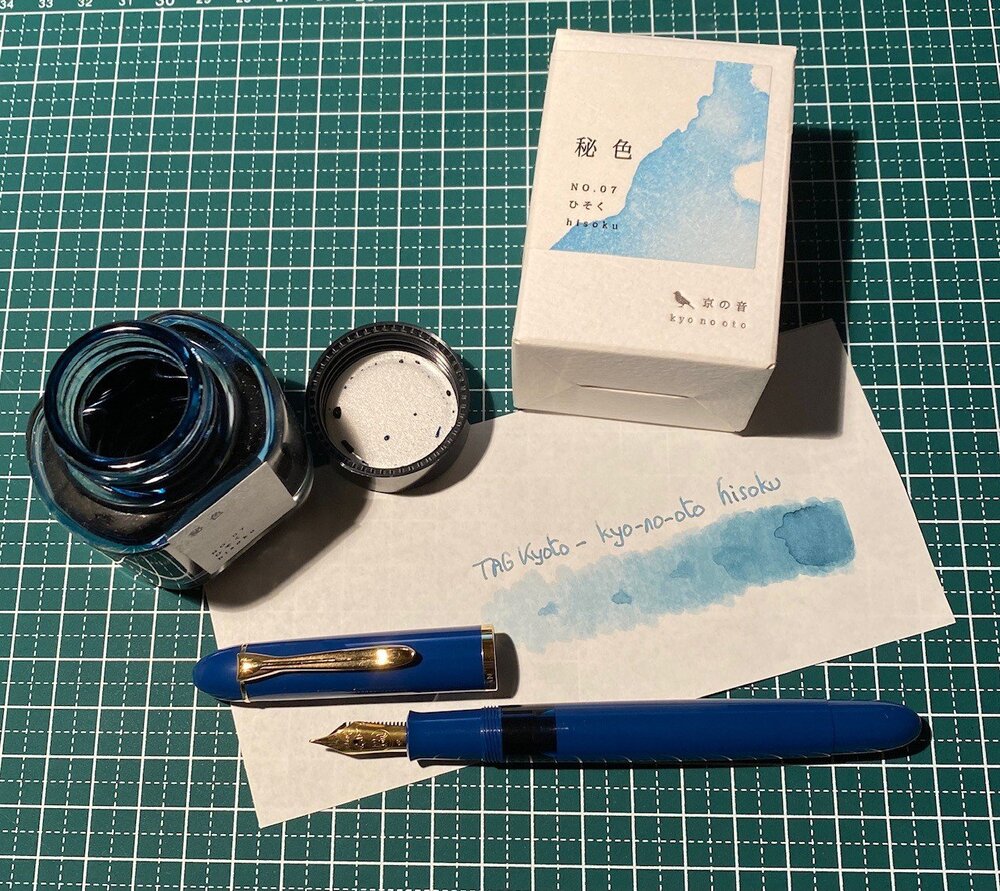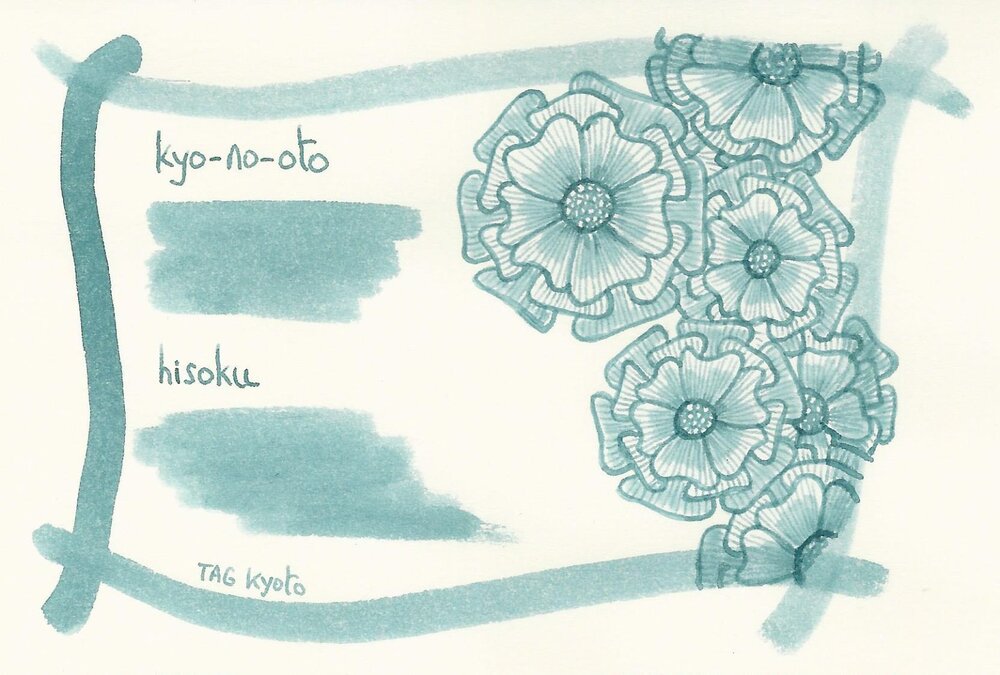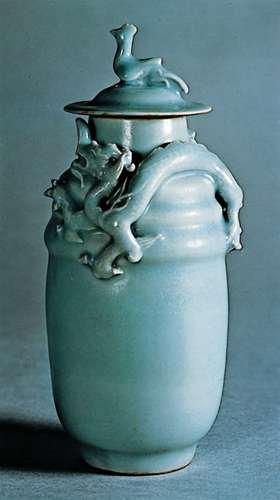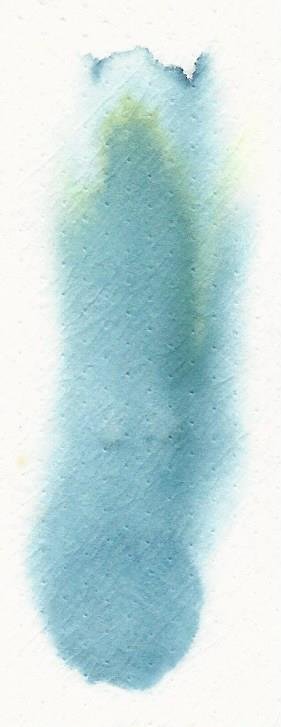Search the Community
Showing results for tags 'kyo-no-oto'.
-
TAG Kyoto – kyo-no-oto – moegiiro TAG is a stationary shop in Kyoto (Japan) that produces some interesting soft watercolour-style inks. With the kyo-no-oto series they produce a line of inks that replicates traditional Japanese dye colours. According to available only info, the manufactu...
- 8 replies
-
- tag kyoto
- kyo-no-oto
-
(and 3 more)
Tagged with:
-
TAG Kyoto – kyo-no-oto – keshimurasaki TAG is a stationary shop in Kyoto (Japan) that produces some interesting soft watercolour-style inks. With the kyo-no-oto series they produce a line of inks that replicates traditional Japanese dye colours. According to available online info, the manufactur...
- 16 replies
-
- tag kyoto
- kyo-no-oto
-
(and 3 more)
Tagged with:
-
TAG Kyoto - kyo-no-oto - sakuranezumi TAG is a stationary shop in Kyoto (Japan) that produces some interesting soft watercolour-style inks. With the kyo-no-oto series they produce a line of inks that replicates traditional Japanese dye colours. According to available only info, the manufact...
- 20 replies
-
- tag kyoto
- kyo-no-oto
-
(and 3 more)
Tagged with:
-
TAG Kyoto – kyo-no-oto #13 seiheki TAG is a stationery shop in Kyoto (Japan) that produces some interesting soft watercolour-style inks. With the kyo-no-oto series they produce a line of inks that replicates traditional Japanese dye colours. According to available online info, t...
- 10 replies
-
- tag kyoto
- kyo-no-oto
-
(and 2 more)
Tagged with:
-
TAG Kyoto – kyo-no-oto ruriiro TAG is a stationary shop in Kyoto (Japan) that produces some interesting soft watercolour-style inks. With the kyo-no-oto series, they produce a line of inks that replicates traditional Japanese dye colours. According to available online info, the...
- 10 replies
-
- tag kyoto
- kyo-no-oto
-
(and 3 more)
Tagged with:
-
TAG Kyoto – kyo-no-oto – imayouiro TAG is a stationary shop in Kyoto (Japan) that produces some interesting soft watercolour-style inks. With the kyo-no-oto series, they produce a line of inks that replicates traditional Japanese dye colours. According to available online info,...
- 8 replies
-
- tag kyoto
- kyo-no-oto
-
(and 2 more)
Tagged with:
-
TAG Kyoto – kyo-no-oto – ginkaisyoku TAG is a stationary shop in Kyoto (Japan) that produces some interesting soft watercolour-style inks. With the kyo-no-oto series, they produce a line of inks that replicates traditional Japanese dye colours. According to available online info...
- 7 replies
-
- tag kyoto
- kyo-no-oto
-
(and 3 more)
Tagged with:
-
TAG Kyoto kyo-no-oto ryokuyuiro TAG is a stationary shop in Kyoto (Japan) that produces some interesting soft watercolour-style inks. With the kyo-no-oto series they produce a line of inks that replicates traditional Japanese dye colours. According to available only info, the ma...
- 10 replies
-
- tag kyoto
- kyo-no-oto
-
(and 2 more)
Tagged with:
-
TAG Kyoto – kyo-no-oto adzukiiro TAG is a stationary shop in Kyoto (Japan) that produces some interesting soft watercolour-style inks. With the kyo-no-oto series they produce a line of inks that replicates traditional Japanese dye colours. According to available online info, the...
- 6 replies
-
- tag kyoto
- kyo-no-oto
-
(and 3 more)
Tagged with:
-
TAG Kyoto – kyo-no-oto ochiguriiro TAG is a stationary shop in Kyoto (Japan) that produces some interesting soft watercolour-style inks. With the kyo-no-oto series they produce a line of inks that replicates traditional Japanese dye colours. According to available only info, the...
- 8 replies
-
- tag kyoto
- kyo-no-oto
-
(and 2 more)
Tagged with:
-
Ink Shoot-Out : Diamine Meadow vs TAG Kyoto kyo-no-oto moegiiro Not so long ago I did a review of kyo-no-oto moegiiro – a yellow-green ink from TAG Kyoto stationery shop. I enjoyed the ink a lot – I just love this shade of green. While preparing the review, I noticed that Diamine Meadow...
- 6 replies
-
- ink shoot-out
- diamine
-
(and 4 more)
Tagged with:
-
TAG Kyoto – kyo-no-oto kokeiro TAG is a stationary shop in Kyoto (Japan) that produces some interesting soft watercolour-style inks. With the kyo-no-oto series they produce a line of inks that replicates traditional Japanese dye colours. According to available only info, the man...
- 8 replies
-
- tag kyoto
- kyo-no-oto
-
(and 3 more)
Tagged with:
-
TAG Kyoto – kyo-no-oto – yamabukiiro TAG is a stationery shop in Kyoto (Japan) that produces some interesting soft watercolour-style inks. With the kyo-no-oto series they produce a line of inks that replicates traditional Japanese dye colours. According to available online info,...
- 10 replies
-
- tag kyoto
- kyo-no-oto
-
(and 3 more)
Tagged with:
-
TAG Kyoto – kyo-no-oto – aonibi TAG is a stationary shop in Kyoto (Japan) that produces some interesting soft watercolour-style inks. With the kyo-no-oto series they produce a line of inks that replicates traditional Japanese dye colours. According to available only info, the ma...
- 9 replies
-
- tag kyoto
- kyo-no-oto
-
(and 2 more)
Tagged with:
-
TAG Kyoto - kyo-no-oto - hisoku TAG is a stationary shop in Kyoto (Japan) that produces some interesting soft watercolour-style inks. With the kyo-no-oto series they produce a line of inks that replicates traditional Japanese dye colours. According to available only info, th...
- 31 replies
-
- tag kyoto
- kyo-no-oto
-
(and 3 more)
Tagged with:
-
TAG Kyoto - kyo-no-oto - urahairo TAG is a stationary shop in Kyoto (Japan) that produces some interesting soft watercolour-style inks. With the kyo-no-oto series they produce a line of inks that replicates traditional Japanese dye colours. According to available only info, the manufactu...
- 3 replies
-
- tag kyoto
- kyo-no-oto
-
(and 2 more)
Tagged with:























